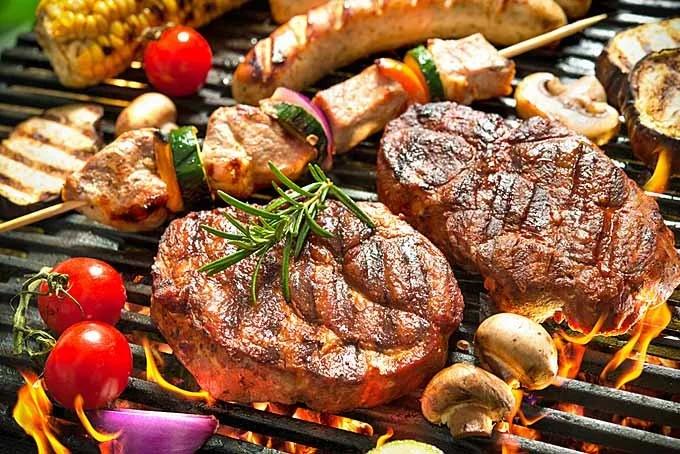Is backyard cooking hazardous to your health? it doesn’t have to be!
All meats have amino acids and sugars, and when grilled at high temperatures they naturally produce molecules called heterocyclic amines (HCAs). And when fat drips and burns, the smokes contains polycyclic aromatic hydrocarbons (PAHs). These two groups of chemicals have been linked to cancer.
Rosemary has the ability to reduce the risk of cancer from eating meats cooked on high heat (includes pan frying) as the antioxidants in rosemary prevent the formation of these carcinogenic compounds.
1. Marinate
Marinades that contain rosemary, thyme, sage, and garlic will also help limit the formation of potential carcinogens. Studies published in the Journal of Food Science found that marinades containing these spices reduced the amount of total HCAs by as much as 90 percent, compared to a control. Their antioxidants help offset harmful effects of grilling. Basil, mint, oregano, turmeric and ginger also possess powerful anticancer action.
Even briefly marinating foods is effective in reducing the amount of carcinogens Use about one-half cup of marinade for every pound of food. The amount of marinating time is up to you because it only takes a few minutes to get the full cancer-preventing effect.
Marinating in red wine for six hours before grilling can also decrease the amount of carcinogens.
Avoid store bought marinades which are usually high in sugar, high fructose corn syrup or other sweeteners.
2. Add Veggies
Antioxidants in fruit and vegetables protect your cells from carcinogens. Always grill veggies over indirect heat to avoid charring.
3. Flip Often
To avoid creating carcinogens flip often. A study published in the Journal of the National Cancer Institute found that frequently flipping a burger combined with low-heat cooking significantly reduced E. coli and produced the lowest level of HCAs. Idea - Fire up one side of the grill and cook on the other.
4. Cut off the Char
Cut it off - it’s just burnt meat. If you do this one thing, you’ll eliminate many of the HCAs that form.
Sources
https://www.ncbi.nlm.nih.gov/pubmed/19241593
https://www.ncbi.nlm.nih.gov/pubmed/20492265
https://academic.oup.com/jnci/article/92/21/1773/2906003
https://www.ncbi.nlm.nih.gov/pubmed/10578481
https://www.ncbi.nlm.nih.gov/pubmed/9216741


